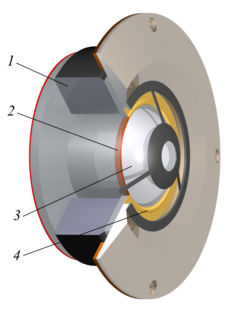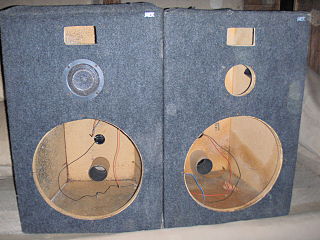
A subwoofer is a loudspeaker designed to reproduce low-pitched audio frequencies known as bass and sub-bass, lower in frequency than those which can be (optimally) generated by a woofer. The typical frequency range for a subwoofer is about 20–200 Hz for consumer products, below 100 Hz for professional live sound, and below 80 Hz in THX-certified systems. Subwoofers are never used alone, as they are intended to augment the low-frequency range of loudspeakers that cover the higher frequency bands. While the term "subwoofer" technically only refers to the speaker driver, in common parlance, the term often refers to a subwoofer driver mounted in a speaker enclosure (cabinet), often with a built-in amplifier.

A loudspeaker is an electroacoustic transducer, that is, a device that converts an electrical audio signal into a corresponding sound. A speaker system, also often simply referred to as a "speaker" or "loudspeaker", comprises one or more such speaker drivers, an enclosure, and electrical connections possibly including a crossover network. The speaker driver can be viewed as a linear motor attached to a diaphragm which couples that motor's movement to motion of air, that is, sound. An audio signal, typically from a microphone, recording, or radio broadcast, is amplified electronically to a power level capable of driving that motor in order to reproduce the sound corresponding to the original unamplified electronic signal. This is thus the opposite function to the microphone, and indeed the dynamic speaker driver, by far the most common type, is a linear motor in the same basic configuration as the dynamic microphone which uses such a motor in reverse, as a generator.

Audio crossovers are a type of electronic filter circuitry that splits an audio signal into two or more frequency ranges, so that the signals can be sent to loudspeaker drivers that are designed to operate within different frequency ranges. The crossover filters can be either active or passive. They are often described as two-way or three-way, which indicate, respectively, that the crossover splits a given signal into two frequency ranges or three frequency ranges. Crossovers are used in loudspeaker cabinets, power amplifiers in consumer electronics and pro audio and musical instrument amplifier products. For the latter two markets, crossovers are used in bass amplifiers, keyboard amplifiers, bass and keyboard speaker enclosures and sound reinforcement system equipment.

A tweeter or treble speaker is a special type of loudspeaker that is designed to produce high audio frequencies, typically deliver high frequencies up to 100 kHz. The name is derived from the high pitched sounds made by some birds (tweets), especially in contrast to the low woofs made by many dogs, after which low-frequency drivers are named (woofers).

A mid-range speaker is a loudspeaker driver that reproduces sound in the frequency range from 250 to 2000 Hz. It is also known as a squawker.
A woofer or bass speaker is a technical term for a loudspeaker driver designed to produce low frequency sounds, typically from 50 Hz up to 1000 Hz. The name is from the onomatopoeic English word for a dog's bark, "woof". The most common design for a woofer is the electrodynamic driver, which typically uses a stiff paper cone, driven by a voice coil surrounded by a magnetic field.

An electrostatic loudspeaker (ESL) is a loudspeaker design in which sound is generated by the force exerted on a membrane suspended in an electrostatic field.
Thiele/Small parameters are a set of electromechanical parameters that define the specified low frequency performance of a loudspeaker driver. These parameters are published in specification sheets by driver manufacturers so that designers have a guide in selecting off-the-shelf drivers for loudspeaker designs. Using these parameters, a loudspeaker designer may simulate the position, velocity and acceleration of the diaphragm, the input impedance and the sound output of a system comprising a loudspeaker and enclosure. Many of the parameters are strictly defined only at the resonant frequency, but the approach is generally applicable in the frequency range where the diaphragm motion is largely pistonic, i.e. when the entire cone moves in and out as a unit without cone breakup.

A bass reflex system is a type of loudspeaker enclosure that uses a port (hole) or vent cut into the cabinet and a section of tubing or pipe affixed to the port. This port enables the sound from the rear side of the diaphragm to increase the efficiency of the system at low frequencies as compared to a typical sealed- or closed-box loudspeaker or an infinite baffle mounting.

Magnepan is a private high-end audio loudspeaker manufacturer in White Bear Lake, Minnesota, United States. Their loudspeaker technology was conceived and implemented by engineer Jim Winey in 1969.
Bowers & Wilkins, commonly known as B&W, is a British company that produces consumer and professional loudspeakers and headphones.

A full-range loudspeaker drive unit is defined as a driver which reproduces as much of the audible frequency range as possible, within the limitations imposed by the physical constraints of a specific design. The frequency range of these drivers is maximized through the use of a whizzer cone and other means. Most single driver systems, such as those in radios, or small computer speaker designs, cannot reproduce all of the audible frequencies or the entire audible audio range.

A loudspeaker enclosure or loudspeaker cabinet is an enclosure in which speaker drivers and associated electronic hardware, such as crossover circuits and, in some cases, power amplifiers, are mounted. Enclosures may range in design from simple, homemade DIY rectangular particleboard boxes to very complex, expensive computer-designed hi-fi cabinets that incorporate composite materials, internal baffles, horns, bass reflex ports and acoustic insulation. Loudspeaker enclosures range in size from small "bookshelf" speaker cabinets with 4-inch (10 cm) woofers and small tweeters designed for listening to music with a hi-fi system in a private home to huge, heavy subwoofer enclosures with multiple 18-inch (46 cm) or even 21-inch (53 cm) speakers in huge enclosures which are designed for use in stadium concert sound reinforcement systems for rock music concerts.

A speaker enclosure using a passive radiator (PR) usually contains an "active loudspeaker", and a passive radiator. The active loudspeaker is a normal driver, and the passive radiator is of similar construction, but without a voice coil and magnet assembly. It is not attached to a voice coil or wired to an electrical circuit or power amplifier. Small and Hurlburt have published the results of research into the analysis and design of passive-radiator loudspeaker systems. The passive-radiator principle was identified as being particularly useful in compact systems where vent realization is difficult or impossible, but it can also be applied satisfactorily to larger systems.

Bi-amping and tri-amping is the practice of using two or three audio amplifiers to amplify different audio frequency ranges, with the amplified signals being routed to different speaker drivers, such as woofers, subwoofers and tweeters. Biamping can be done with a single power amplifier if the device has more than one amplifier, as the case with a stereo power amp. Triamping cannot be done with a stereo power amp; a mono power amp would need to be added or a home theatre receiver could be used. With bi-amping and tri-amping, an audio crossover is used to divide a sound signal into different frequency ranges, each of which is then separately amplified and routed to separate loudspeaker drivers. In some bass amplifiers using bi-amping, the woofer and horn-loaded tweeter are in the same speaker enclosure. In some bi-amp set-ups, the drivers are in separate speaker enclosures, such as with home stereos that contain two speakers and a separate subwoofer.
The Air Motion Transformer (AMT) is a type of electroacoustic transducer. Invented by noted physicist and scientist Dr. Oskar Heil (1908–1994), it operates on a different transduction principle from other loudspeaker designs, such as moving coil, planar magnetic or electrostatically driven loudspeakers, and should not be confused with planar or true ribbon loudspeakers. In contrast to a planar ribbon loudspeaker, the diaphragm of the AMT is of pleated shape similar to a bellows. The AMT moves air laterally in a perpendicular motion using a metal-etched folded sheet made of polyethylene terephthalate (PET) film. The circuit path embossed on the PET membrane, acts as the voice coil unit. The diaphragm is then housed between 4 stacks of steel pole-plate pieces positioned at 45° within a high-intensity, quadratic, opposing magnetic field. The air motion transformer with its sheet film equally exposed at 180° behaves as a dipole speaker, exciting front and rear sonic waves simultaneously.

Acoustic suspension is a method of loudspeaker cabinet design and utilisation that uses one or more loudspeaker drivers mounted in a sealed box or cabinet. Acoustic suspension systems reduce bass distortion that can be caused by stiff motor suspensions in conventional loudspeakers.
wOOx technology is a brand created by Philips to identify loudspeaker systems that employ passive radiator technology in conjunction with active equalization to maximize the output of the passive diaphragm. wOOx Technology optimizes the active bass driver, the passive bass radiator, and the active equalization curve to obtain maximum low-frequency reproduction in a relatively compact configuration.

An electrodynamic speaker driver, often called simply a speaker driver when the type is implicit, is an individual transducer that converts an electrical audio signal to sound waves. While the term is sometimes used interchangeably with the term speaker (loudspeaker), it is usually applied to specialized transducers which reproduce only a portion of the audible frequency range. For high fidelity reproduction of sound, multiple loudspeakers are often mounted in the same enclosure, each reproducing a different part of the audible frequency range. In this case the individual speakers are referred to as drivers and the entire unit is called a loudspeaker. Drivers made for reproducing high audio frequencies are called tweeters, those for middle frequencies are called mid-range drivers, and those for low frequencies are called woofers, while those for very low bass range are subwoofers. Less common types of drivers are supertweeters and rotary woofers.
Loudspeaker time-alignment usually simply referred to as "time-alignment" or "Time-Align" is a term applied in loudspeaker systems which use multiple drivers to cover a wide audio range. It involves delaying the sound emanating from one or more drivers to correct the transient response, improve accuracy and, in non-coaxial drivers, improve the directivity or lobe tilting at the crossover frequencies. It employs adjusting the front-to back spacing of the individual drivers so that the sound output is truly simultaneous.













